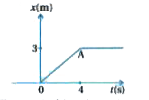The motion of a particle of mass m is given by x = 0 for t < 0 s, x (t) = A sin 4π t for 0 < t < (1/4) s (A>0), and x = 0 for t > (1/4) s. which of the following statements is true?/Solution in Punjabi
The force at t = (1/8) s on the particle is −16π2 A m.
The particle is acted upon by on impulse of magnitude 4π2 A m at t = 0 s aand t = (1/4) s.
The particle is not acted upon by any force
The particle is not acted upon by a constant force.
Step by step video & image solution for The motion of a particle of mass m is given by x = 0 for t < 0 s, x (t) = A sin 4pi t for 0 < t < (1/4) s (A>0), and x = 0 for t > (1/4) s. which of the following statements is true?/ by Physics experts to help you in doubts & scoring excellent marks in Class 11 exams.
Topper's Solved these Questions
Similar Questions
What is the difference between gravity and gravitation?
03:46View SolutionWhat is the unit of torr?
05:03View SolutionThe value of lim_(x rarr0)int_(0)^(x)(t ln(1+t))/(t^(4)+4)dt
04:31View SolutionThe motion of a particle of mass m is given by x=0 for tlt0s , x(t)=Asin4pit for 0lttlt((1)/(4))s(Agt0) ,and x=0 for tgt((1)/(4))s .
05:09View SolutionThe position of a particle moving on the x-axis is given by x=t^(3)+4t^(2)-2t+5 where x is in meter and t is in seconds (i) the velocity of the particle at t=4 s is 78 m//s (ii) the acceleration of the particle at t=4 s is 32 m//s^(2) (iii) the average velocity during the interval t=0 to t=4 s is 30 m//s (iv) the average acceleration during the interval t=0 to t=4 s is 20 m//s^(2)
02:27View SolutionFig. shows the position-time graph of a particle of mass 4 kg. What is the (i) force acting on the particle for t lt 0, t lt 4 s, 0 lt t lt 4 s ? (ii) impulse at t = 0 and t = 4 s? Assume that the motion is one dimensional.
03:49View SolutionThe motion of a particle of mass m is given by x=0 for t lt 0 s, x (t) = A sin 4pit for 0 lt t(1//4) s (A gt 0) and x=0 for t gt (1//4) s Which of the following statement(s) is (are) true?
05:06View Solutionएक कण t = 0 से चलना प्रारंभ करता है । t समय में कण द्वारा चली हुई दुरी s=(2.5m/s2)t2 से प्राप्त होती है । (a) समय t = 0 से 4 .0 तक में कण की औसत चाल बताएँ। (b) t = 4. 0 s पर कण की चाल बताएँ।
03:56View SolutionA particle moves along x-axis and its acceleration at any time t is a = 2 sin (πt), where t is in seconds and a is in m/s2 . The initial velocity of particle (at time t = 0) is u = 0.
Q. Then the distance travelled (in meters) by the particle from time t = 0 to t = 1 s will be :05:33View SolutionA particle is at x =+ 5 m at t =0,x =- 7 m at t = 6 s and x = + 2 at t = 10s. Find the average velocity of the particle during the intervals
(a)t=0 to t=6s
(b)t=6s to 6=10s
(c ) t=0 to t=10s .View SolutionFig. shows the position-time graph of a particle of mass 4 kg. What is the (i) force acting on the particle for t lt 0, t lt 4 s, 0 lt t lt 4 s ? (ii) impulse at t = 0 and t = 4 s? Assume that the motion is one dimensional.
04:39View SolutionFigure shows the position-time graph of a particle of mass 4 kg, then
a) force on the particle for t<0,t>4s,0<t<4s? ?
b) impulse at t = 0 and t = 4 s. (consider one-dimensional motion only)
 05:01View Solution
05:01View SolutionA particle is at x=+5 m at t=0,
x=-7m at t=6 s and x =+2 at t=10s.Find the averahe velocity of the particle during the intervals
(a)t=0 to t=6s
(b)t=6s to t=10s,
©t=0 to t=10 s.04:17View SolutionShows the position-time graph of a particle of mass 4 kg. What is the (a) force on the particle for t<0,t>4s,0<t<4 s ? (b) impulse at t = 0 and t = 4 s ? (Consider onedimensional motion only).
 13:03View Solution
13:03View SolutionThe motion of a particle of mass m is given by x = 0 for t lt 0 s, x(t) = A sin 4pit for 0 lt t lt (1/4) s (A gt 0) and x =0 for t gt(1/4) s which of the following statements is true ?
05:36View SolutionLet S={t∈R:f(x)=|x−π|(e|x|−1)sin|x| is not differentiable at t} Then the set S is equal to: (1) ϕ (2) {0} (3) {π} (4) {0,π}
View Solution

